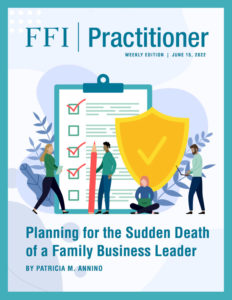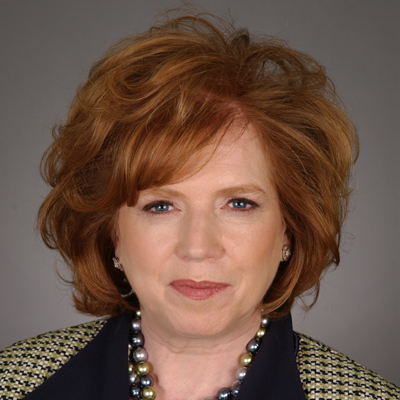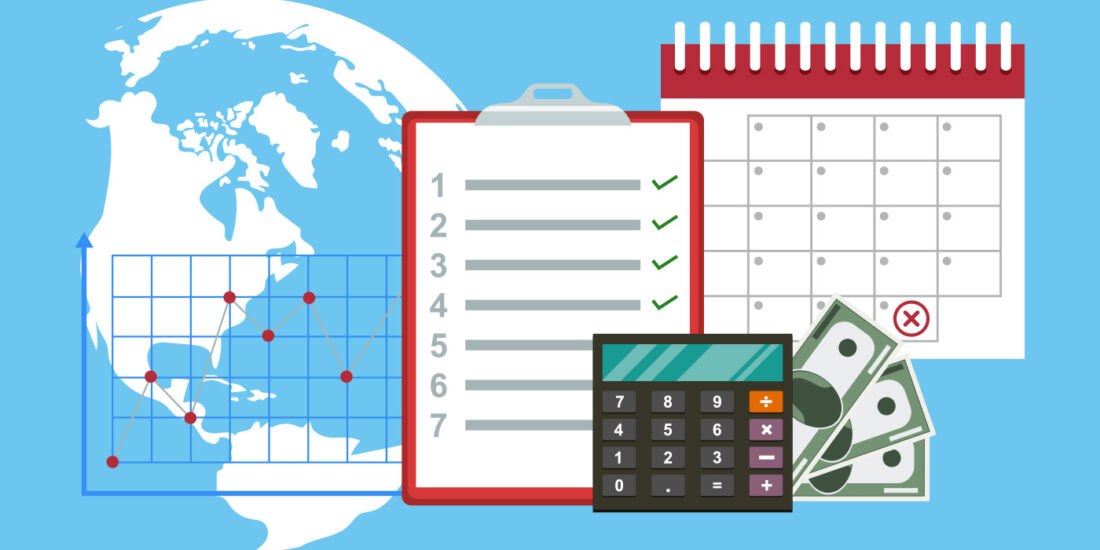
View this edition in our enhanced digital edition format with supporting visual insight and information.
In this week’s edition of FFI Practitioner, FFI Fellow Patricia Annino explores the impact that the sudden death of a family business leader can have on the entire enterprise. In her article, Patricia shares examples and insights from her experience and provides tips to practitioners to help ensure their clients are prepared should such an unexpected event occur.
A few years ago, a client who owned a family business died in race car accident. Four women (and their parents) each sent a heart shaped bouquet of flowers to the funeral home. Each of the women was engaged to him and thought she was the only one. Needless to say, his business affairs were in the same state as his personal life—confused and disorganized. While alive, he hid it well. He charmed many people, made a tremendous amount of money, spent a great deal of money, and covered a lot of missteps.
Sudden death can bring surprises, grief, heartache, loss, confusion, fear, financial stress, and legal hassles. So why is it that so many family businesses do not make planning for the sudden death of a founder or key executive a priority, or at least a question to be answered?
It is human nature to put off what seems less important today, because we can always “do it tomorrow.” Yet we all know the best time to plan is when there is no need to.
Some people keep their plans a secret. According to an October 2021 New York Times article by Katherine Rosman and Elizabeth Harris1, M. Richard Robinson, Jr., the 84-year-old Chairman and CEO of Scholastic (the son of the founder), died suddenly while taking a walk with his sons and former wife on Martha’s Vineyard. Scholastic’s counsel called Iole Lucchese, an employee of the company for 30 years and a senior executive, to tell her that Mr. Robinson had left the Class A voting shares (the controlling interest of the company, all held in Trust) to her in his Will, bypassing his sons.
Board members were shocked. David Wallack, a portfolio manager for T. Rowe Price and Scholastic’s largest investor after the family, was not aware of the succession plan, and when he had asked Mr. Robinson if there was one, he replied that there was an envelope in the safe and when opened, it would show his wishes. Mr. Wallack had never met Ms. Lucchese, who put a new management team in place. Mr. Robinson’s sister is reported as saying that the company is in good hands.
In contrast, a client of mine who founded an import-export business was given a dire health projection and knew he only had four to six weeks to live. He called me with the news and asked me to set up a meeting with him, his wife, and his adult children. One of his sons was his “heir apparent” in management. At that meeting, he told all of us that he knew he would not live much longer, and knew that he did not have time to teach his son everything he would need to know to run the business the same way he was running it. He explained to all of them that because of his prior planning (putting a $10 million life insurance policy in place for his wife and the family’s benefit), his wife (their mother)’s financial future would not depend on the success of the business. He then told his son in front of the family that with that in mind, he wanted his son to know that he should not fight any ghost discussions they had had along the way. Rather it was now going to be his son’s decision how to run the business or whether to sell all or parts of the business. If his son tried and did not succeed, he said, neither the son nor any family members should consider it to be a failure.
Everyone in the room cried. He died a month later and his son ran (and continues to run) a contracted version of the business. That was one of the most poignant meetings of my career, and it is still with me today. That discussion took wisdom, courage, strength, and love.
Sudden death can strike at any time—and when that happens, years and even decades of work can go up in flames in an instant.
Planning matters. The process of planning matters. The sudden death of a founder has legal, financial, tax, business operation, and psychological ramifications for all stakeholders. The consequences of a sudden death are not transitory: they will last for years. The grieving process takes time. The decision process will be impaired. Failure to plan has consequences. Banks and financial institutions may become spooked. The business may be sold at less than an advantageous price. Conflict may take place among owners as to future plans and goals.
Family business advisors should do all they can to motivate the family business to put a proper succession plan in place and monitor it on an ongoing basis.
These are the key components of an effective plan:
- A clear operational succession plan. This should include an understanding of which candidates are the best suited to fill the leadership void. In all likelihood, this will include internal and external candidates. Since this will constantly change, the succession plan should be reviewed and revised at least annually.
- A short-term plan and a long-term plan. A short-term plan should include how to handle the announcement of the death (media management) and an understanding of the immediate pressure points (bank loans, financing, debt management, cash flow issues, and check signing authority). It may be prudent to meet with key customers and investors to inform them of the planning process, so they do not feel excluded. The long-term plan should include review of the management team and any staffing changes.
- Proper and up-to-date estate planning. This includes the basic documents, such as will, trust, disability and life insurance, buy-out agreements, up-to-date valuation of the entities, and an understanding of debt services.
- A coordination of estate planning with the corporate planning. Frequently there is a disconnect between the two, as different advisors with different skill sets are working on the separate pieces of the puzzle. Integration of these pieces, much like a jigsaw puzzle, is what creates a coherent picture, or in the case of business succession, a coherent plan.
- An understanding of the psychology that could accompany a sudden death. Decision making will slow down. Grief will ensue. Anger is likely. The loss must be processed. Negotiations will take a different tone. When another client’s young husband, the CEO of a family business, died very suddenly playing sports, she was named in his will as his executor. He was not the sole owner of the business, and negotiations commenced over the next year. She brought an 8” x 11” framed photo of him to every meeting and put it on the conference room table. It was a poignant reminder to his brothers of his presence and importance. (Grace Moussaid, Trabulsi Hussein, and Hussein Akil introduced the concept of “double loss,”2 noting that in the process of mourning, while a widow can do nothing about the loss of her husband, she can resist the loss of the family business. This can lead to slower decision making and a desire to keep the business alive as part of the decedent’s legacy.)
- A method to establish the financial value of the decedent’s interest. This is not only important from a tax point of view, but also if the decedent was not the sole owner and his/her estate is now obligated to sell the interest. Additionally, it is also a relevant factor as part of the overall analysis of whether to maintain, sell, shrink, or split.
- A focus on the legacy of the decedent and the preparation of a statement (to be referenced upon the decedent’s passing) about the values the decedent and the business stand for. This helps with the grieving process, and it also helps with the branding and management of the business. It provides a forum for those connected to the family and the business to come together and remember the underlying importance of the mission.
The sudden death of a family business founder or key stakeholder will have profound impacts on the family and the business for years to come. A strong and flexible governance structure matters. Open communication matters. Understanding that planning is a process that should be continued and evolutionary is critical. But families don’t have to do this alone. Involving personal and business advisors is key to a successful plan, as it is a responsibility of those advisors to put these issues front and center before the family and the business, and to guide the family to that coherent picture.
References
1Rosman, K., & Harris, E.A. (2021, October 25). Inside the Real-Life Succession Battle at Scholastic. The New York Times. https://www.nytimes.com/2021/10/18/business/scholastic-iole-lucchese-succession-battle.html
2Moussaid, G., Hussein, T., & Akil, H. (2019). The Challenge in Pain: The Delayed Bereavement at the Origin of the Act of Entry into Business of the Widow. International Business Research, 12(6), 99-105. https://doi.org/10.5539/ibr.v12n6p99
About the Contributor

Patricia M. Annino, FFI Fellow, is an attorney with Rimôn, P.C. in Boston. The 2022 recipient of the Richard Beckhard Practice Award, Patricia is a former member of the FFI board of directors, a founding member of the 2086 Society, and a frequent contributor to FFI Practitioner. She has been voted by her peers as one of the Best Lawyers in America, Estate Planner of the Year and EuroMoney’s “Best in Wealth Management — USA.” Her most recent book is Power, Strength & Perseverance: What Women Know About Other Women, but Search for in Themselves. She can be reached at patricia.annino@rimonlaw.com.

View this edition in our enhanced digital edition format with supporting visual insight and information.





